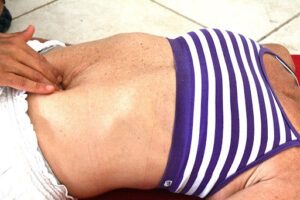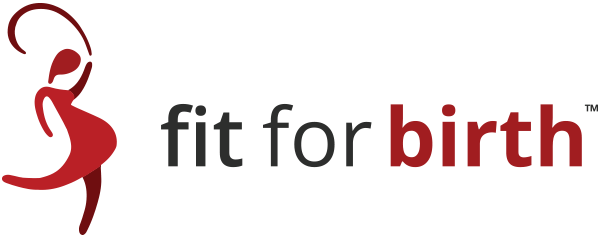Last Updated 11/16/23

Six Aspects for Healing Diastasis Recti
There are 6 specific factors to address when it comes to healing diastasis recti (DR), the separation of the abdominal wall that is commonly associated with pregnancy. Scientific research is commonly inconclusive, and non-replicable, leading people to be confused as to what actually works. Establishing a more comprehensive agreement for how to define DR (beyond just size of the gap), dramatically helps to determine exactly what benefits occur from various treatment programs. Here at Fit For Birth, we define diastasis recti as the following 6 aspects. Check in with yourself in order to make sure you are clear about where you’re going in your fitness and healing journey.
1. Width – Width is the current scientific standard that is measured (>20mm). Whenever the researchers are talking about inter-recti distance (IRD), this is the factor that they are trying to determine the degree of separation (wide or narrow) between the two sides of the rectus abdominis. Some evidence currently indicates that crunches may help to narrow the gap, as opposed to other abdominal exercises. Although width is a great piece of the equation, it is not necessarily correlative to pain or function. This means that we must also assess other factors of DR
2. Integrity – Integrity is the firmness of the linea alba (LA) collagen band between the two sides of the abdominal wall. Some women are so soft in this location (because the tissue has stretched so far) that the touch of their toddler’s hand can feel like a punch to the inner organs. Integrity of tendons (including the LA tendinous sheath) is well proven to improve (become more firm) with strength training in general, including abdominal exercises.
3. Function – Function is the most important physical factor when it comes to various associated symptoms of DR. What this means is that, even if the gap is wider than before, attaining good core function, both inner and outer core, is what relieves things like back pain, pelvic pain and even incontinence. Function is also what often has primary governance over whether or not the stomach falls forward, lending a woman to feel like she constantly looks “three months pregnant” even many years later. Over the years, I have seen that as a woman achieves good function, she is no longer likely to have complaints of her diastasis. Research studies really need to start separating the improvements in “width” from improvements in function. These are two very different things, as a person with normal width can have terrible function (and pains), while a person with a large gap can have amazing function (with no pain).
4. Body Fat – Body fat is a factor that can make a postpartum woman feel like her diastasis is worse than it is. In fact, I have found cases where there was no significant gap at all, and it was just a need to address her overall exercise and nutrition habits, and maybe other lifestyle factors too. For all intents and purposes, reducing body fat is a relatively straight-forward case of burning body fat as fuel (simple, but not necessarily easy for many, of course). The solution here will often come from foundational movement, nutrition and sleep habits.
5. Skin – Skin stretches alongside the linea alba, as one’s pregnant belly grows. Whether or not stretch marks and later “excess skin” shows up postpartum is based upon one’s genetic tendencies, as well as nutritional (hydration of the skin, and nutrient intake) and functional capacities (how you use your tummy muscles can increase or decrease that stretching effect). Current scientific opinion is that once the collagen bands have broken (whether it’s the collagen in the LA or the skin), that tissue cannot be easily repaired without surgery. Again, prevention from having excess skin postpartum is more likely to happen in those who practice foundational core function and nutrition, as well as sleep habits.
6. Mind – Mind is the most important factor of all because what one believes about her DR affects all other factors we’ve discussed thus far. In short, I have seen women who have a very small gap, good integrity, a near 6-pack, who simply do not like the change in their postpartum body. At the same time, I have seen women with large DR, and still more body fat than they’d prefer, but who love their body because of how it represents something more due to the pressures of pregnancy and motherhood. To some women, their postpartum DR stomach now represents their strength in having accomplished one of the most grueling physical and mental-emotional events that a person can experience in their lifetime. And so, after addressing the width, integrity, function, body fat, and skin, the question remains, “How do I feel about myself now?”
Assessing each of these 6 areas is critically important before giving up, or opting for diastasis surgery.
If you want a personal assessment of these six aspects for your postpartum tummy, Fit For Birth coaches can help, particularly those who have the Pre & Postnatal Diastasis and Core Consultant (PPDCC) credential.

How to Heal DR, or Know if I Need Surgery for it?
Solve Diastasis Recti in these 3 steps:
- In most cases, DR will be solved effectively by first achieving proper function. Proper function naturally improves integrity and width. Yes, there are certain exercises (or more commonly how you do the exercises) that can emphasize closure of the gap. In addition, there are exercises that can make pain manageable. In most cases, this is what needs to be addressed first when it comes to putting DR behind you once and for all.
- Then, or along the way, addressing overall exercise and nutrition habits will address any excess body fat (and help clarify if there is truly excess skin). It must be confirmed whether or not excess body fat and skin are part of the equation, and if they are, a plan to specifically address them must be created. This will usually involve an analysis including questions like: (a) Are your movement habits supporting or hurting your goals, and (b) Are your nutritional habits supporting or hurting your goals.
- Finally, mindset will not only improve from practicing better function and exercise/nutrition habits in general, but can also be focused upon directly. This can be done at typical “meditation times” of morning and evening, as well as in the midst of an exercise session, and in a variety of other ways. Many simply do not realize how critically impactful their minds are to their perception of wellbeing.
There are some cases of DR that will benefit from surgery, but usually these are the absolute widest gaps that prevent good core function from being able to make the usual improvements. In most cases, it’s wisest to first address function, exercise & nutrition habits, and mindfulness before deciding whether or not to opt for surgery.
—————————————————-
James Goodlatte is a Father, Holistic Health Coach, Corrective Exercise Practitioner, Speaker, Author, Professional Educator, and the founder of Fit For Birth. Since 2008, when he found out he would be a father, his passion for holistic wellness shifted to children and families. Today, he is a driving force in providing Continuing Education Credits for the pre and postnatal world, with Fit For Birth professionals in 52 countries. James is also the program director for Fit For Birth pre & postnatal personal training worldwide, and is a contributing member of the First 1000 Days Initiative at the Global Wellness Institute.
